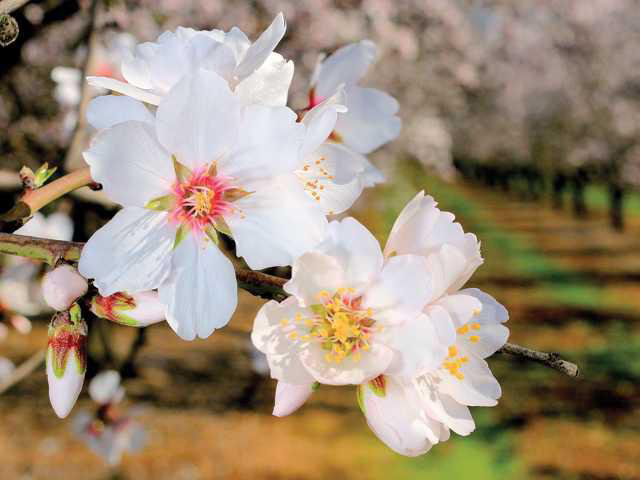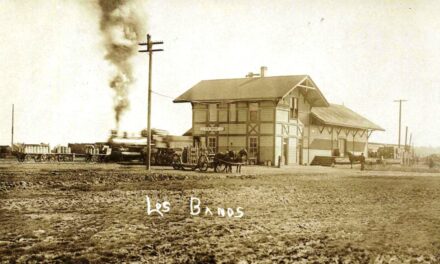Almond — is it pronounced “ahl-mond” with a soft “A” and soft “L” or is it “aah-men” with a hard “A” and neatly silent “H”?
In many parts of Northern California they will tell you it’s the latter. Their rationale: You have to knock the “L” out of trees to shake loose the nuts.
And they aren’t kidding about knocking the hell out of almond trees. Before mechanical shakers hit the market some 50 to 60 years ago, it was usual for many teen boys and young men looking for some extra cash to spend the late summer swinging heavy mallets to repeatedly shake almonds out of trees.
Almonds are the No. 1 agricultural crop — it slipped to No. 2 overall in California in 2019 after being edged by milk.
Speaking of milk, it is a four-letter word as far as many in the dairy industry are concerned when it appears after the word “almond”. There is serious squabble going on regarding what’s in a name given almond milk and other “milk” made from products such as soybeans are nipping at the heels of milk sales. The dairy folks say milk comes from animals.
That said almond milk is not a Johnny Come Lately creation although it certainly did not beat cow’s milk to man’s table. Muslims are credited with “inventing” almond milk in the 13th century.
Almonds are not native to California. But you couldn’t tell that in terms of the almonds grown on 1.5 million acres in the Great Central Valley that account for 80 percent of the world’s almond production.
No other country comes close. Spain is next with 202,339 tons but it pales on comparison with the 2 billion plus tons California produces.
If San Joaquin County was its own country, it would have been the fifth largest nation in terms of almond production in 2019 with 89,000 tons. San Joaquin County would have been sandwiched between Morocco with 112,681 tons and Syria with 88,840 tons.
But compares to other counties in California, San Joaquin County doesn’t make the top five.
It would be No. 6 on the list behind Kern County with 160,158 tons, Fresno County with 145,382 tons, Stanislaus County with 122,571 tons, Merced County with 110,071 tons, and Madera County with 101,071 tons.
To put San Joaquin County’s production in perspective at $449.6 million it wasn’t quite a third of the $1.5 billion that Fresno County grew in 2019. That’s the equivalent of three-quarters of the entire $2 billion overall agricultural production for San Joaquin County.
Fresno County, by the way, is still the largest agricultural producing county in the United States. With $7.1 billion in crop output in 2019 it would rank 23rd highest as a state. Little wonder they feel comfortable calling their county fair that typically draws 600,000 a year the Big Fresno Fair.
Agriculture is still king in California as the Golden State’s $50 billion is $22 billion higher than its closest competitor which is Iowa. California produced 13.7 percent of the nation’s $369 billion in agricultural crops last year with most that in the 450 mile long and the 40 to 60 mile wide Great Central Valley.
And yes, we do indeed have a lot of fruits and nuts in this state. In fact two thirds of all fruits and nuts grown in this country are from California.
Topping the nuts and fruit list by far is almonds at $6.09 billion wedges between milk at No. 1 with $7.34 billion and all grapes at No. 3 with $5.21 billion.
California exports almonds to 90 countries. The top importer is India. The $100 million they bought in 2019 constituted the largest commodify this country exported to India. Almost 70 percent of all exported almonds are shelled.
They are the fifth biggest California export after, in descending order, aircraft and engines, electric vehicles, unmounted diamonds, and modems and similar communication devices.
Overall the direct economic benefit to the state is pegged at $9.2 billion and directly/indirectly provides 110,000 jobs.
This might surprise you but there are more than 100 varieties of almonds grown in California. The nonpareil is the leading variety followed by Monterey, Butte, Carmel, and Padre.
Almonds are not grown commercially anywhere else in the country. That’s because nowhere else in the nation is there a state can replicate California’s hot dry Mediterranean climate with a well-developed water infrastructure system.
Here are a few more tidbits about California almonds:
*More than 90 percent of all almond farms are family farms.
*Many farms are second and third generation.
*Farmers have reduced the amount of water needed for grow a pound of almonds over the last 20 years by 33 percent.
*Growers are working on reducing that by another 20 percent by 2025 using micro-irrigation techniques.
*Dormant almond orchards are being explored as a viable way to disperse excess storm water in wet years to replenish underground aquifers. Initial analysis shows 675,000 acres of almonds have soul conducive for that purpose.
*No part of the almond goes to waste. The shells are jaws for livestock bedding and as dairy feed. They also can be used to generate electricity as can the trees at the end of their lives.
*Although the California Almond Board won’t shout about due to the environmental lobby, but as a hard wood almond logs are considered more effective in this that still have wood bending fireplaces.
*There are 7,600 almond farms in California.
*Research shows California almonds have a lower-carbon footprint than a number of otherness nutrient-dense foods.
*The pollination of almond orchards is the biggest of its kind drawing honey bee hives from across the nation in what is also the first crop pollination of the year.
*Blue Diamond indicates depending upon the variety and conditions it can take an almond tree five to 12 years to start producing almonds.
*Most almond trees produce almonds for 25 years.
*The nuts, depending upon the variety, can take 180 to 240 days to mature.
*An average commercial almond tree yields between 50 and 65 pounds.




